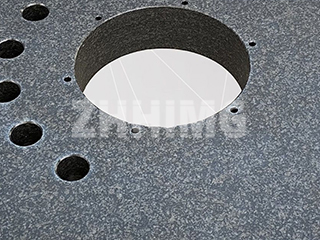Granite surface plates are widely used in industrial settings for precision measurement, calibration, and inspection tasks. Due to their high dimensional stability and durability, they have become essential tools in manufacturing environments. This article will outline the main characteristics of granite surface plates and provide a step-by-step guide on how to install and level them correctly.
How to Install and Adjust a Granite Surface Plate
Before putting your granite surface plate into service, proper setup and adjustment are crucial to ensuring optimal accuracy. Here’s how to proceed:
1. Unpacking and Inspection
Carefully remove the packaging and inspect the plate for any signs of damage, especially edge chips or surface cracks.
Note: The precision surface is always the top face of the plate.
2. Positioning on Support Stand
If you are using a dedicated granite stand, use a forklift to gently place the plate onto the frame. Ensure the plate is fully supported and the weight is evenly distributed.
3. Leveling the Plate
Use the leveling bolts or jacks (commonly five-point supports) integrated into the stand to fine-tune the flatness. If the ground is uneven, adjust the base bolts accordingly to maintain balance and alignment.
4. Surface Cleaning
Wipe the surface clean with a soft cloth to remove any dust or debris that could affect measurement precision.
5. Final Check
Once the plate is stable and clean, you can proceed with calibration or inspection tasks.
Key Properties and Advantages of Granite Surface Plates
Granite surface plates offer several performance benefits that make them ideal for precision metrology:
Dense and Wear-Resistant Structure
The fine-grain crystalline structure ensures a smooth, durable working surface with minimal roughness.
Excellent Dimensional Stability
Natural granite undergoes millions of years of geological aging, eliminating internal stress and ensuring long-term shape retention.
Chemical Resistance
Resistant to acids, alkalis, and most corrosive substances, making them suitable for tough industrial environments.
Rust-Free and Low Maintenance
Unlike metal plates, granite does not rust or absorb moisture, and it requires minimal upkeep.
Low Thermal Expansion
Granite has a very low coefficient of thermal expansion, maintaining accuracy even in fluctuating temperatures.
No Raised Burrs
When impacted or scratched, granite forms small indentations rather than raised burrs—preserving the integrity of the measurement surface.
Step-by-Step Leveling Procedure
Place the plate on a flat surface and adjust the four corners to stabilize it manually.
Transfer the plate onto its support frame and position the load-bearing points as symmetrically as possible.
Begin by adjusting each foot until all contact points share the load equally.
Use a precision level (e.g., bubble level or electronic level) to verify horizontal alignment. Adjust supports until perfectly level.
Let the platform rest for 12 hours, then re-check flatness and levelness. Repeat adjustment if necessary.
Establish a regular maintenance schedule based on environmental conditions to ensure continued accuracy.
Conclusion:
Granite surface plates are reliable, long-lasting, and essential for high-precision work. By following proper setup procedures and understanding their unique properties, users can maximize their performance and accuracy over time.
Post time: Jul-28-2025

